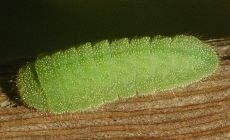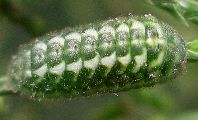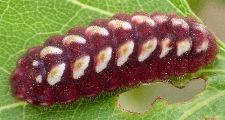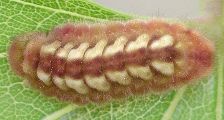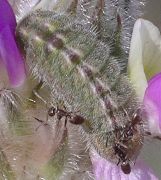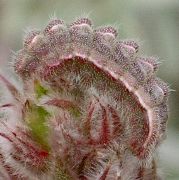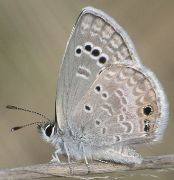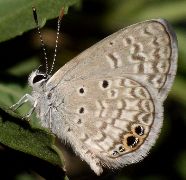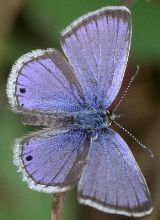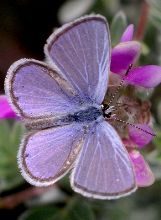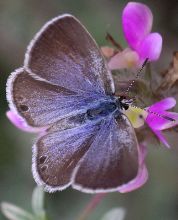
| Lycaenidae ~ Blues, Hairstreaks |
page 1 ![]() page 2
page 2
|
The family Lycaenidae, commonly called the gossamer-winged butterflies, has four distinct subfamilies. Only two of those occur in our area: the blues and the hairstreaks. These are all small butterflies, but they have some striking markings, especially the metallic highlights that adorn most of them.
The caterpillars of both hairstreaks and blues look much the same: slug-like, usually with a repeating pattern of chevrons or broken stripes, and covered with very short hairs. Since they are small (10-15 mm), they are often very hard to find. Between extremely variable coloration, which can change to match their food plants, and the similarity between species, identifying the caterpillars is often challenging, to say the least.
Caterpillars of the Gray Hairstreak (Strymon melinus) are only easier to find than other species because they are so numerous in our area. They feed on the flowers of many plants, including legumes and mallows. Their color often comes close to whatever they are feeding on and can be green, brown, cream, or pinkish,
One hairstreak whose larvae cannot be mistaken for any other species is the Juniper Hairstreak (Callophrys gryneus). The caterpillars feed on trees in the genus Juniperus, including Eastern Red Cedar and Ashe Juniper. The insects are so perfectly camouflaged on the scaly leaves of the trees that they are rarely found.
Henry's Elfin (Callophrys henrici) caterpillars appear for a short time each spring, most often feeding on Texas Redbud (Cercis canadensis). As this tree blooms just as the leaves start to appear, the larvae tend to be colored deep magenta more often than not. They match the early buds and flowers perfectly. While this species can also come in a green form, the closest I've found is a sort of light orange color. It is easiest to see these caterpillars when they are climbing down the trunks of the trees in order to pupate. There are several species of blues in our area, and the caterpillars are not easy to tell apart. They are much like the larvae of hairstreaks, but are relatively smaller and tend to have more colorful markings. Those that I've found have been on the buds and flowers of legumes.
The only species whose larvae's identity I'm fairly certain of is Reakirt's Blue (Hemiargus isola). When only one species' adults are present for a period, followed by numerous caterpillars that all look similar, it's probably a good bet that they are related. During the winter, Reakirt's Blue caterpillars can be found feeding on Gregg's Dalea (Dalea greggii). Their variable coloration blends in perfectly and the 10 mm long caterpillars are very hard to find, even though they are quite numerous. One way to find them is to look for ants. These caterpillars produce a sweat secretion, much like aphids or planthoppers do, and the ants readily feed on it. In return, the caterpillars gain protection from parasites and predators.
When it comes to adults, there are two blues which are closely related and commonly found in our area. Reakirt's Blue (Hemiargus isola) is by far the most common, while the Ceraunus Blue (Hemiargus ceraunus) is the next most often seen. Identification usually depends on getting a good look at the underside of the forewings. Reakirt's Blue has a string of round black spots, while the Ceraunus Blue has a ragged line of dashes that are the same color as most of the other surrounding markings. The hind wings of both species have black eyespots towards the rear of the underside. These are found on many hairstreaks and blues, and serve the purpose to attract predators' attention away from the head of the insect. The general color of the underside of the Ceraunus Blue is more tan while Reakirt's Blue is often more gray. Both species have a wide range, from light to dark, for most of the under wing markings, which determines how much the few black spots stand out.
Although the blues usually rest with their wings closed, they sometimes open up to bask, especially on cold sunny days. There is very little on the tops of the wings that helps distinguish Ceraunus from Reakirt's Blues. Females look very much the same, with brown wings that turn blue towards the body, and variable black spots at the rear of the hind wings. The males are more blue on top. Reakirt's Blue has slightly larger single black spots at the back of the hind wings than Ceraunus Blue, while the latter's tiny spots sometimes even blend right into the dark edge. There is also a slight difference in the width of the dark edge, especially towards the tips of the forewings: Ceraunus Blue has thin margins while Reakirt's Blue has wider ones. The blue color on these butterflies is dependent on reflection of light and so changes with angle or brightness. It is not a particularly reliable identification clue and every individual seems to have a different hue. They are often quite lovely. |
page 1 ![]() page 2
page 2
![]()


